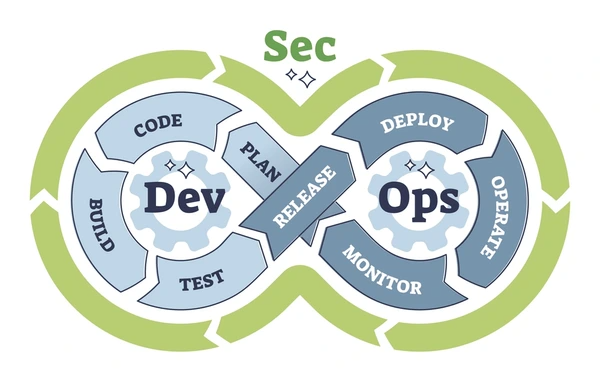Search This Blog
Welcome to Financially Free, your guide to taking control of your money. Learn to budget, pay off debt, and invest wisely. We provide practical advice and simple strategies to help you build wealth and achieve true financial independence. It's time to live life on your terms.
Axos ONE
Featured
- Get link
- X
- Other Apps
DevSecOps And Its Key Components
DevSecOps And Its Key Components
Understanding DevSecOps
DevSecOps is a software development methodology that combines Development, Security, and Operations, emphasizing security as a shared responsibility throughout the entire IT lifecycle. It integrates security practices from the beginning of the application development process, rather than treating security as an isolated function at the end of the development cycle.
Development
The development component focuses on incorporating security into the core of the software development lifecycle (SDLC). This approach ensures that security is a fundamental part of the planning and coding stages, enabling developers to proactively address potential vulnerabilities.
Security
Security is integrated at every stage of the application lifecycle. By implementing a Secure Software Development Lifecycle (SSDLC), organizations can embed security measures into each phase, from design to deployment.
"Security integration is not just a step, it's a culture that permeates the entire development process."
Operations
Operations in DevSecOps emphasize continuous monitoring and automation. By adopting practices such as Infrastructure as Code (IaC) and automated security testing, organizations can maintain rapid development cycles without compromising security.
Overall, DevSecOps aims to create a culture of security awareness and proactive risk management, enabling organizations to deliver secure applications efficiently.
Why Security is Essential in Software Development
Incorporating security from the inception of the software development process is crucial. As cyberattacks grow more sophisticated, embedding security measures throughout the software development life cycle (SDLC) ensures a robust framework that protects against potential breaches. Early integration of security helps in understanding risks, setting clear objectives, and designing secure applications.
DevSecOps plays a pivotal role in facilitating this integration. By embedding security as code within the DevOps pipeline, it ensures security is a continuous concern, not just an afterthought. This approach allows for automated security checks and fosters a shared responsibility model across development teams.
|
Statistic |
Value |
|
|
Average cost of a data breach |
$3.86 million |
|
|
Total public data breaches since 2005 |
Over 9,044 |
|
|
Largest data breach (Cam 4) |
10 billion accounts |
Examples of security lapses, such as the Cam 4 breach impacting billions of accounts, highlight the scale and repercussions of inadequate security measures. These breaches often lead to financial losses, reputational damage, and regulatory penalties.
- Minimizes the risk of vulnerabilities
- Ensures compliance with regulations
- Protects user privacy and system integrity
Ultimately, prioritizing security from the start not only mitigates risks but also enhances trust and efficiency in software delivery.
Benefits of Implementing DevSecOps
Faster and More Secure Software Releases
By integrating continuous security testing into the development pipeline, DevSecOps enables quicker software delivery. Automated security reviews and testing throughout the development cycle ensure vulnerabilities are identified and resolved early. This approach streamlines workflows and reduces the likelihood of security issues in production releases.
Improved Team Collaboration
DevSecOps fosters a collaborative culture by breaking down silos between development and security teams. By promoting transparency and shared accountability, teams can communicate effectively and address issues promptly, enhancing productivity and aligning goals across departments. Organizations such as Capital One have demonstrated improved outcomes by adopting this integrated approach.
Reduced Risk of Security Breaches
"DevSecOps reduces the risk of security breaches by embedding security at every stage of development."
With early vulnerability detection and rapid incident response, DevSecOps minimizes the window of opportunity for attackers. Real-world examples, like Adobe’s implementation of DevSecOps, highlight how organizations can effectively safeguard their systems and data, reducing potential damages and enhancing trust.
Best Practices for DevSecOps Implementation
Successfully implementing DevSecOps requires strategic approaches that integrate security into every aspect of the software development lifecycle. Here are some best practices:
- Automating Security Tests: Leveraging automation tools like Snyk, Aqua Security, and OWASP ZAP helps streamline security testing. These tools can be integrated into CI/CD pipelines to ensure continuous vulnerability assessments without hindering development speed. Companies like Netflix have effectively used automation to maintain robust security checks.
- Integrating Security Tools into the Development Pipeline: Incorporating security mechanisms early in the development process is crucial. For instance, container security tools such as Calico Open Source and Clair help manage vulnerabilities in containerized environments. By doing so, organizations like Adobe have maintained secure development environments.
- Promoting a Culture of Security: Building a security-aware workforce is fundamental. As noted, "Leadership commitment is crucial for establishing a security culture." Companies such as Google emphasize continuous security training and encourage shared responsibility among team members, fostering a proactive security mindset.
By adopting these practices, organizations can enhance their security posture, ensuring both efficient and secure software delivery.
- Get link
- X
- Other Apps
Popular Posts
Next.js Partial Prerendering: The End of the Static vs. Dynamic Trade-off
- Get link
- X
- Other Apps
Gemini 3 is Here: The AI That Finally "Reads the Room"
- Get link
- X
- Other Apps





Comments
Post a Comment